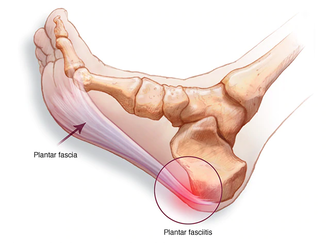|
By Holly Pennington, PT, DPT/Outpatient Physical Therapy  If your first steps in the morning make you groan and hold your toes up while you walk, you may be suffering from one of the most common running injuries: plantar fasciitis. When the soft tissue that stretches from the heel to the long bones of the feet becomes irritated, a degenerative process causing pain and stiffness in the foot and heel can result. Because the plantar fascia supports the arch of the foot and is related to the Achilles tendon, runners are prime candidates for this persistent, painful condition. For a quick and practical guide to plantar fasciitis, read on! What causes plantar fasciitis? While plantar fasciitis can come on insidiously, there are a few common specific causes in runners. Both the Achilles tendon and plantar fascia attach to the calcaneus (heel bone), so a shortened Achilles tendon (related to tight calf muscles) can lead to plantar fasciitis. Runners who overpronate place a repetitive strain the plantar fascia, so they are at increased risk for this condition. Frequent and repetitive pounding of pavement is another reason the fascia can become irritated, so runners who do not vary their terrain may end up with foot pain. Finally, a more subtle cause of plantar fasciitis in runners is weakness of the small muscles in the feet that contract when toes are “scrunched.” What are the most effective treatments? Because plantar fasciitis is a common condition in both the general and athletic populations, there is an abundance of procedures, splints, shoes and contraptions that claim to cure and prevent it. However, scientific research shows physical therapy is the single best treatment for this condition. Physical therapy that includes a combination of manual therapy (joint and soft tissue mobilization), stretching and strengthening results in a quicker reduction in pain at less cost than other types of treatments. They also evaluate the role of the knee and hip in foot mechanics to get to the root cause of precursors like shortened Achilles tendons and overpronation. Physical therapy may also include recommendations for over the counter foot orthoses, such as Superfeet, to help decrease strain on the plantar fascia. What do I do next? If you are suffering from plantar fasciitis and need physical therapy, check with your insurance company first. Some insurances require a referral from a primary care provider while others permit you to go directly to physical therapy. Once the initial evaluation is complete, physical therapists typically recommend 8-10 visits over a period of 4-6 weeks to treat this condition. And, perhaps your most pressing question: Do I have to quit training? No! You may need to make temporary changes such as varying your running surface and strategic additions of specific strengthening and stretching exercises, but you do not have to stop running, cycling or swimming. Suffering from foot pain? Call an Outpatient Physical Therapy clinic near you to schedule an evaluation: www.outpatientpt.com
0 Comments
Your comment will be posted after it is approved.
Leave a Reply. |
Raise the BarRace reports, upcoming events, news, and more, from RTB. Archives
September 2023
|
 RSS Feed
RSS Feed




